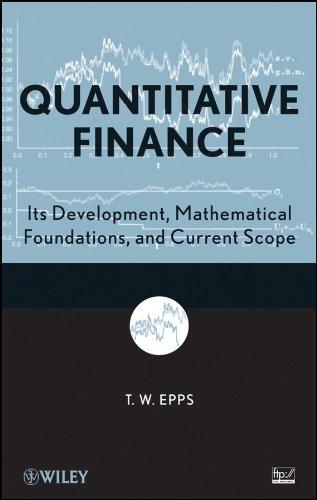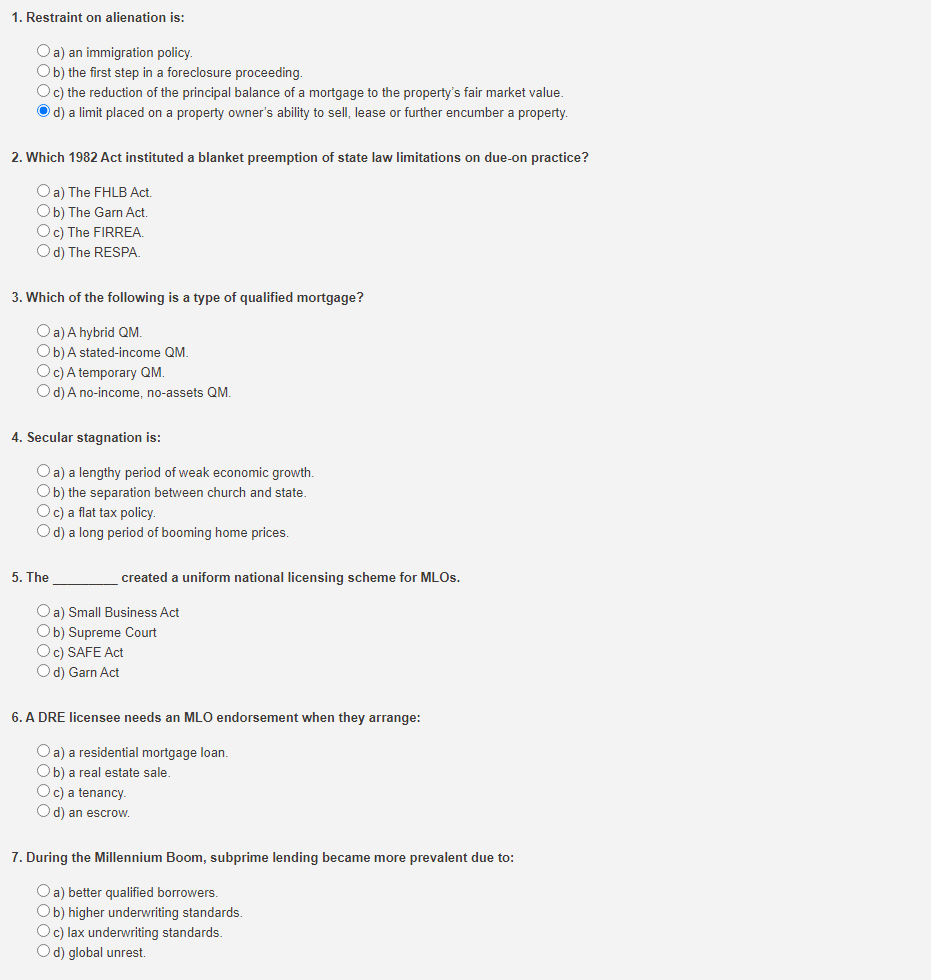

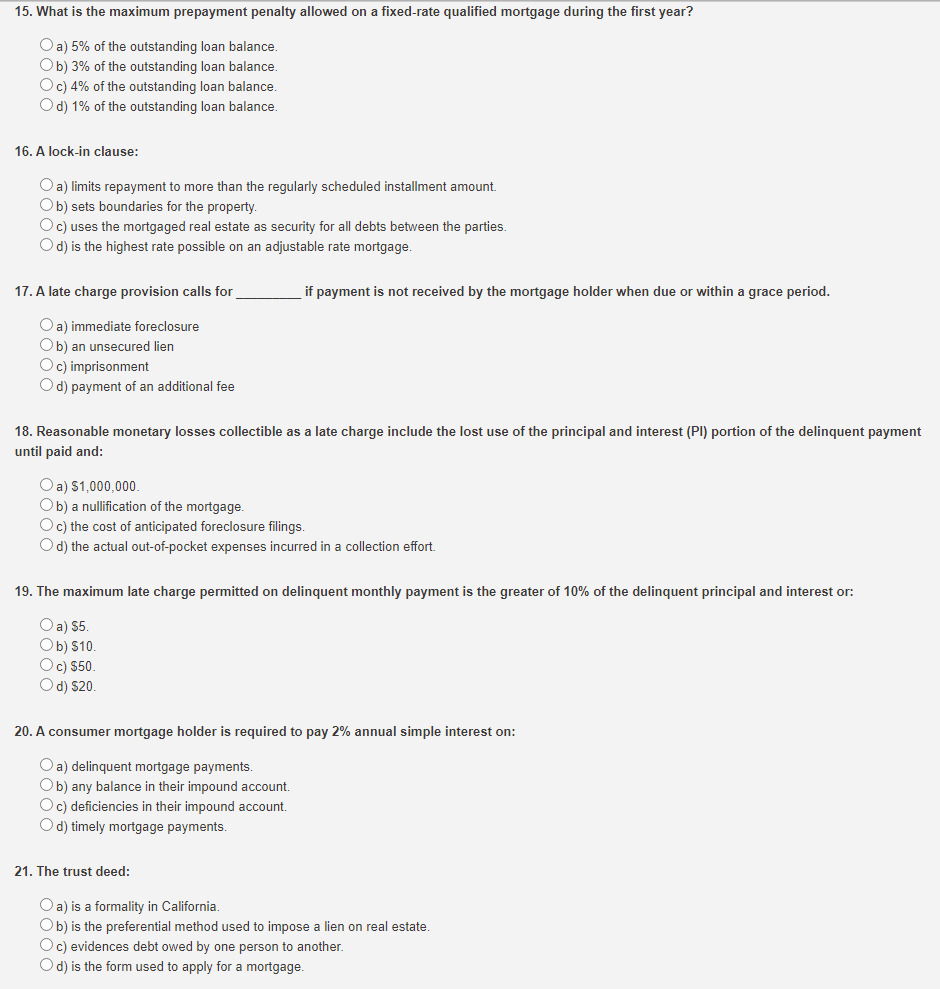
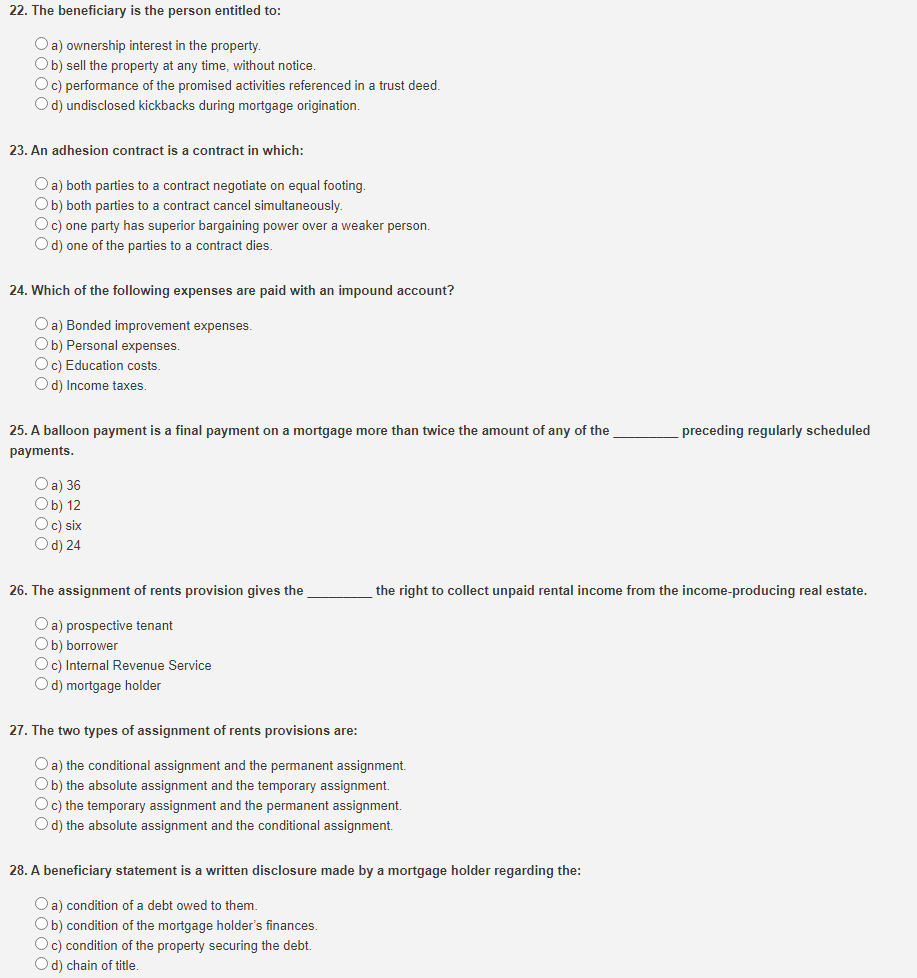
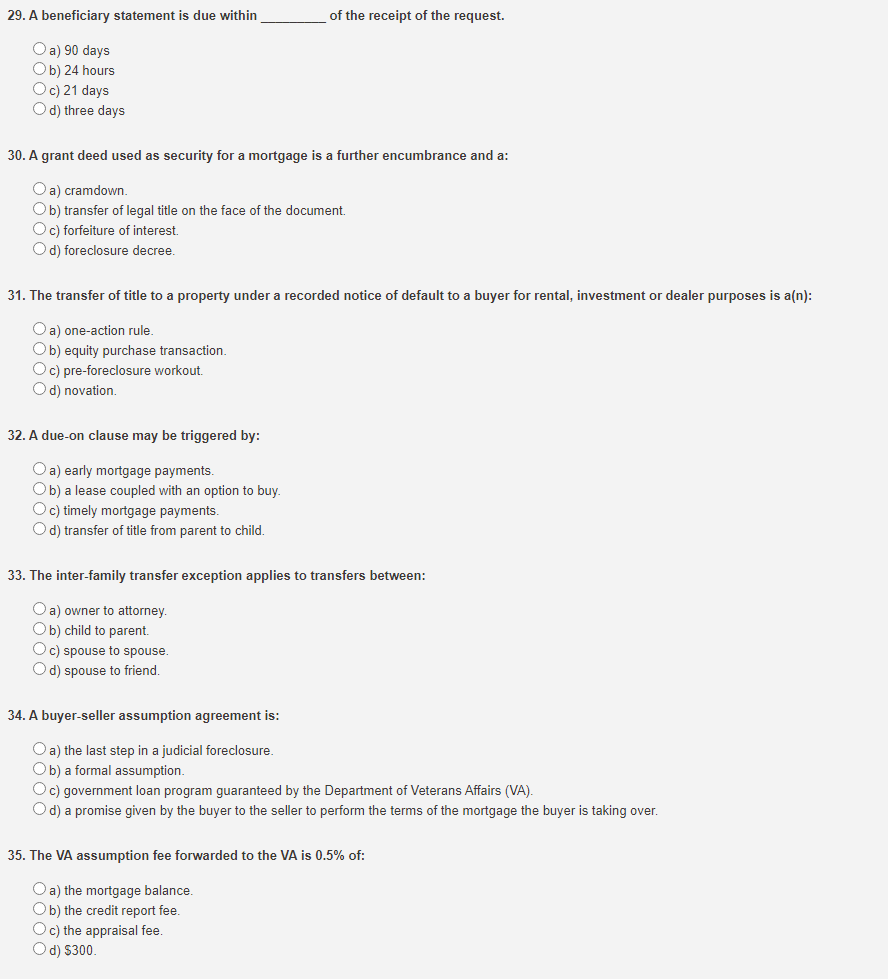
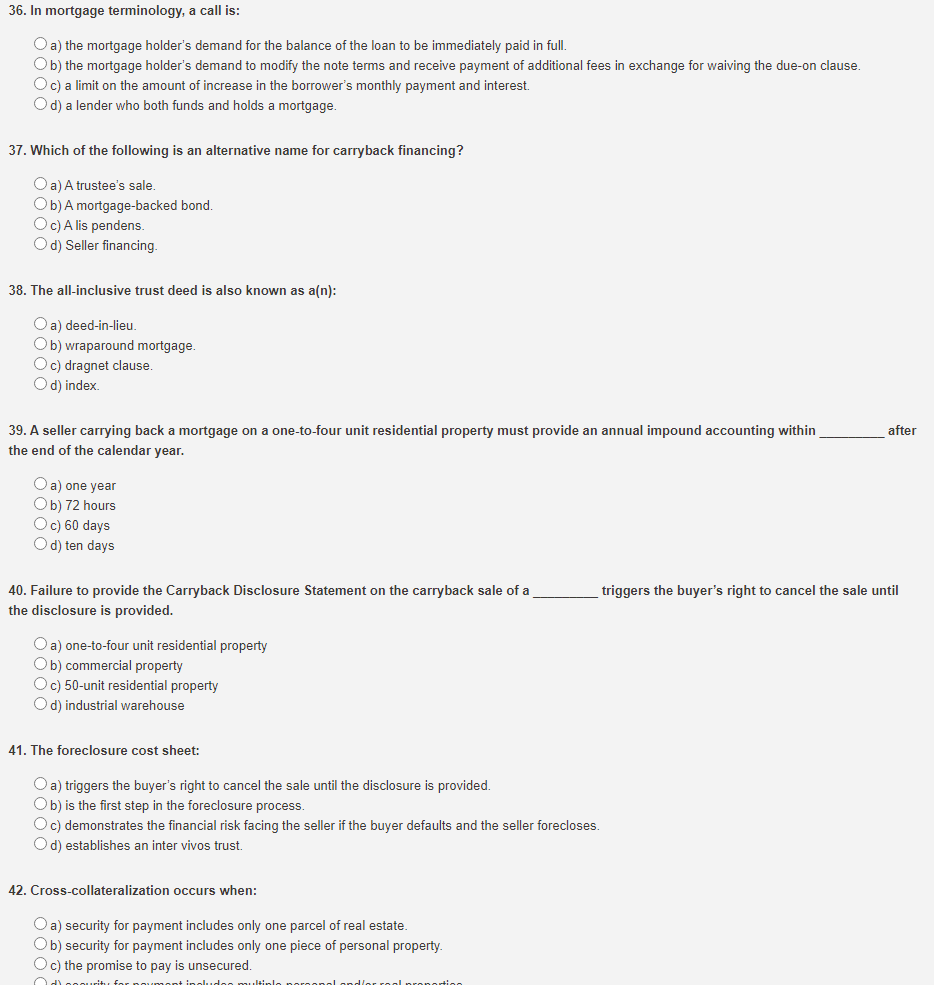
1. Restraint on alienation is: a) an immigration policy. b) the first step in a foreclosure proceeding. c) the reduction of the principal balance of a mortgage to the property's fair market value. d) a limit placed on a property owner's ability to sell, lease or further encumber a property. 2. Which 1982 Act instituted a blanket preemption of state law limitations on due-on practice? a) The FHLB Act. b) The Garn Act. c) The FIRREA. d) The RESPA. 3. Which of the following is a type of qualified mortgage? a) A hybrid QM. b) A stated-income QM. c) A temporary QM. d) A no-income, no-assets QM. 4. Secular stagnation is: a) a lengthy period of weak economic growth. b) the separation between church and state. c) a flat tax policy. d) a long period of booming home prices. 5. The created a uniform national licensing scheme for MLOs. a) Small Business Act b) Supreme Court c) SAFE Act d) Garn Act 6. A DRE licensee needs an MLO endorsement when they arrange: a) a residential mortgage loan. b) a real estate sale. c) a tenancy. d) an escrow. 7. During the Millennium Boom, subprime lending became more prevalent due to: a) better qualified borrowers. b) higher underwriting standards. c) lax underwriting standards. d) global unrest. 8. An installment note requires: a) no payments of principal or interest. b) periodic payments of principal and interest until the principal is paid in full. c) no payments of interest. d) a lump sum payment of principal and interest. 9. A promissory note is a document given as evidence of: a) bankruptcy. b) fire damage. c) insurance coverage. d) a debt owed by one person to another. 10. A shared appreciation mortgage (SAM) is a type of: a) mortgage insurance. b) fixed rate note. c) split-rate note. d) straight note. 11. An allonge is: a) a written modification agreement attached to a note. b) the act of diminishing the value of an interest held by another in real estate. c) personal property attached to real estate as an improvement. d) the term lenders use to identify the buyer's agent in a sales transaction. 12. An exculpatory clause in a note: a) converts a mortgage holder's recourse paper into nonrecourse paper. b) limits the amount of increase in the borrower's monthly payment. c) converts a fixed rate to an adjustable rate. d) limits the property taxes paid to a maximum of 1% of the property's value. 13. Subordination occurs when: a) a mortgage lien takes a lesser or junior position to another lien on the property. b) a mortgage is paid off. c) a borrower pays capital gains taxes. d) a lender goes bankrupt. 14. A prepayment penalty provision allows a mortgage holder the right to charge the property owner a fee for: a) a late mortgage payment. b) setting up a monthly auto-payment. c) early payoff of the principal balance. d) paying an extra month's principal. 15. What is the maximum prepayment penalty allowed on a fixed-rate qualified mortgage during the first year? a) 5% of the outstanding loan balance. b) 3% of the outstanding loan balance. c) 4% of the outstanding loan balance. d) 1% of the outstanding loan balance. 16. A lock-in clause: a) limits repayment to more than the regularly scheduled installment amount. b) sets boundaries for the property. c) uses the mortgaged real estate as security for all debts between the parties. d) is the highest rate possible on an adjustable rate mortgage. 17. A late charge provision calls for if payment is not received by the mortgage holder when due or within a grace period. a) immediate foreclosure b) an unsecured lien c) imprisonment d) payment of an additional fee 18. Reasonable monetary losses collectible as a late charge include the lost use of the principal and interest (PI) portion of the delinquent paymer until paid and: a) $1,000,000. b) a nullification of the mortgage. c) the cost of anticipated foreclosure filings. d) the actual out-of-pocket expenses incurred in a collection effort. 19. The maximum late charge permitted on delinquent monthly payment is the greater of 10% of the delinquent principal and interest or: a) $5. b) $10. c) $50. d) $20. 20. A consumer mortgage holder is required to pay 2% annual simple interest on: a) delinquent mortgage payments. b) any balance in their impound account. c) deficiencies in their impound account. d) timely mortgage payments. 21. The trust deed: a) is a formality in California. b) is the preferential method used to impose a lien on real estate. c) evidences debt owed by one person to another. d) is the form used to apply for a mortgage. 22. The beneficiary is the person entitled to: a) ownership interest in the property. b) sell the property at any time, without notice. c) performance of the promised activities referenced in a trust deed. d) undisclosed kickbacks during mortgage origination. 23. An adhesion contract is a contract in which: a) both parties to a contract negotiate on equal footing. b) both parties to a contract cancel simultaneously. c) one party has superior bargaining power over a weaker person. d) one of the parties to a contract dies. 24. Which of the following expenses are paid with an impound account? a) Bonded improvement expenses. b) Personal expenses. c) Education costs. d) Income taxes. 25. A balloon payment is a final payment on a mortgage more than twice the amount of any of the preceding regularly scheduled payments. a) 36 b) 12 c) six d) 24 26. The assignment of rents provision gives the the right to collect unpaid rental income from the income-producing real estate. a) prospective tenant b) borrower c) Internal Revenue Service d) mortgage holder 27. The two types of assignment of rents provisions are: a) the conditional assignment and the permanent assignment. b) the absolute assignment and the temporary assignment. c) the temporary assignment and the permanent assignment. d) the absolute assignment and the conditional assignment. 28. A beneficiary statement is a written disclosure made by a mortgage holder regarding the: a) condition of a debt owed to them. b) condition of the mortgage holder's finances. c) condition of the property securing the debt. d) chain of title. 29. A beneficiary statement is due within of the receipt of the request. a) 90 days b) 24 hours c) 21 days d) three days 30. A grant deed used as security for a mortgage is a further encumbrance and a: a) cramdown. b) transfer of legal title on the face of the document. c) forfeiture of interest. d) foreclosure decree. 31. The transfer of title to a property under a recorded notice of default to a buyer for rental, investment or dealer purposes is a(n): a) one-action rule. b) equity purchase transaction. c) pre-foreclosure workout. d) novation. 32. A due-on clause may be triggered by: a) early mortgage payments. b) a lease coupled with an option to buy. c) timely mortgage payments. d) transfer of title from parent to child. 33. The inter-family transfer exception applies to transfers between: a) owner to attorney. b) child to parent. c) spouse to spouse. d) spouse to friend. 34. A buyer-seller assumption agreement is: a) the last step in a judicial foreclosure. b) a formal assumption. c) government loan program guaranteed by the Department of Veterans Affairs (VA). d) a promise given by the buyer to the seller to perform the terms of the mortgage the buyer is taking over. 35. The VA assumption fee forwarded to the VA is 0.5% of: a) the mortgage balance. b) the credit report fee. c) the appraisal fee. d) $300. 36. In mortgage terminology, a call is: a) the mortgage holder's demand for the balance of the loan to be immediately paid in full. b) the mortgage holder's demand to modify the note terms and receive payment of additional fees in exchange for waiving the due-on clause. c) a limit on the amount of increase in the borrower's monthly payment and interest. d) a lender who both funds and holds a mortgage. 37. Which of the following is an alternative name for carryback financing? a) A trustee's sale. b) A mortgage-backed bond. c) A lis pendens. d) Seller financing. 38. The all-inclusive trust deed is also known as a(n): a) deed-in-lieu. b) wraparound mortgage. c) dragnet clause. d) index. 39. A seller carrying back a mortgage on a one-to-four unit residential property must provide an annual impound accounting within after the end of the calendar year. a) one year b) 72 hours c) 60 days d) ten days 40. Failure to provide the Carryback Disclosure Statement on the carryback sale of a triggers the buyer's right to cancel the sale until the disclosure is provided. a) one-to-four unit residential property b) commercial property c) 50-unit residential property d) industrial warehouse 41. The foreclosure cost sheet: a) triggers the buyer's right to cancel the sale until the disclosure is provided. b) is the first step in the foreclosure process. c) demonstrates the financial risk facing the seller if the buyer defaults and the seller forecloses. d) establishes an inter vivos trust. 42. Cross-collateralization occurs when: a) security for payment includes only one parcel of real estate. b) security for payment includes only one piece of personal property. c) the promise to pay is unsecured. 1. Restraint on alienation is: a) an immigration policy. b) the first step in a foreclosure proceeding. c) the reduction of the principal balance of a mortgage to the property's fair market value. d) a limit placed on a property owner's ability to sell, lease or further encumber a property. 2. Which 1982 Act instituted a blanket preemption of state law limitations on due-on practice? a) The FHLB Act. b) The Garn Act. c) The FIRREA. d) The RESPA. 3. Which of the following is a type of qualified mortgage? a) A hybrid QM. b) A stated-income QM. c) A temporary QM. d) A no-income, no-assets QM. 4. Secular stagnation is: a) a lengthy period of weak economic growth. b) the separation between church and state. c) a flat tax policy. d) a long period of booming home prices. 5. The created a uniform national licensing scheme for MLOs. a) Small Business Act b) Supreme Court c) SAFE Act d) Garn Act 6. A DRE licensee needs an MLO endorsement when they arrange: a) a residential mortgage loan. b) a real estate sale. c) a tenancy. d) an escrow. 7. During the Millennium Boom, subprime lending became more prevalent due to: a) better qualified borrowers. b) higher underwriting standards. c) lax underwriting standards. d) global unrest. 8. An installment note requires: a) no payments of principal or interest. b) periodic payments of principal and interest until the principal is paid in full. c) no payments of interest. d) a lump sum payment of principal and interest. 9. A promissory note is a document given as evidence of: a) bankruptcy. b) fire damage. c) insurance coverage. d) a debt owed by one person to another. 10. A shared appreciation mortgage (SAM) is a type of: a) mortgage insurance. b) fixed rate note. c) split-rate note. d) straight note. 11. An allonge is: a) a written modification agreement attached to a note. b) the act of diminishing the value of an interest held by another in real estate. c) personal property attached to real estate as an improvement. d) the term lenders use to identify the buyer's agent in a sales transaction. 12. An exculpatory clause in a note: a) converts a mortgage holder's recourse paper into nonrecourse paper. b) limits the amount of increase in the borrower's monthly payment. c) converts a fixed rate to an adjustable rate. d) limits the property taxes paid to a maximum of 1% of the property's value. 13. Subordination occurs when: a) a mortgage lien takes a lesser or junior position to another lien on the property. b) a mortgage is paid off. c) a borrower pays capital gains taxes. d) a lender goes bankrupt. 14. A prepayment penalty provision allows a mortgage holder the right to charge the property owner a fee for: a) a late mortgage payment. b) setting up a monthly auto-payment. c) early payoff of the principal balance. d) paying an extra month's principal. 15. What is the maximum prepayment penalty allowed on a fixed-rate qualified mortgage during the first year? a) 5% of the outstanding loan balance. b) 3% of the outstanding loan balance. c) 4% of the outstanding loan balance. d) 1% of the outstanding loan balance. 16. A lock-in clause: a) limits repayment to more than the regularly scheduled installment amount. b) sets boundaries for the property. c) uses the mortgaged real estate as security for all debts between the parties. d) is the highest rate possible on an adjustable rate mortgage. 17. A late charge provision calls for if payment is not received by the mortgage holder when due or within a grace period. a) immediate foreclosure b) an unsecured lien c) imprisonment d) payment of an additional fee 18. Reasonable monetary losses collectible as a late charge include the lost use of the principal and interest (PI) portion of the delinquent paymer until paid and: a) $1,000,000. b) a nullification of the mortgage. c) the cost of anticipated foreclosure filings. d) the actual out-of-pocket expenses incurred in a collection effort. 19. The maximum late charge permitted on delinquent monthly payment is the greater of 10% of the delinquent principal and interest or: a) $5. b) $10. c) $50. d) $20. 20. A consumer mortgage holder is required to pay 2% annual simple interest on: a) delinquent mortgage payments. b) any balance in their impound account. c) deficiencies in their impound account. d) timely mortgage payments. 21. The trust deed: a) is a formality in California. b) is the preferential method used to impose a lien on real estate. c) evidences debt owed by one person to another. d) is the form used to apply for a mortgage. 22. The beneficiary is the person entitled to: a) ownership interest in the property. b) sell the property at any time, without notice. c) performance of the promised activities referenced in a trust deed. d) undisclosed kickbacks during mortgage origination. 23. An adhesion contract is a contract in which: a) both parties to a contract negotiate on equal footing. b) both parties to a contract cancel simultaneously. c) one party has superior bargaining power over a weaker person. d) one of the parties to a contract dies. 24. Which of the following expenses are paid with an impound account? a) Bonded improvement expenses. b) Personal expenses. c) Education costs. d) Income taxes. 25. A balloon payment is a final payment on a mortgage more than twice the amount of any of the preceding regularly scheduled payments. a) 36 b) 12 c) six d) 24 26. The assignment of rents provision gives the the right to collect unpaid rental income from the income-producing real estate. a) prospective tenant b) borrower c) Internal Revenue Service d) mortgage holder 27. The two types of assignment of rents provisions are: a) the conditional assignment and the permanent assignment. b) the absolute assignment and the temporary assignment. c) the temporary assignment and the permanent assignment. d) the absolute assignment and the conditional assignment. 28. A beneficiary statement is a written disclosure made by a mortgage holder regarding the: a) condition of a debt owed to them. b) condition of the mortgage holder's finances. c) condition of the property securing the debt. d) chain of title. 29. A beneficiary statement is due within of the receipt of the request. a) 90 days b) 24 hours c) 21 days d) three days 30. A grant deed used as security for a mortgage is a further encumbrance and a: a) cramdown. b) transfer of legal title on the face of the document. c) forfeiture of interest. d) foreclosure decree. 31. The transfer of title to a property under a recorded notice of default to a buyer for rental, investment or dealer purposes is a(n): a) one-action rule. b) equity purchase transaction. c) pre-foreclosure workout. d) novation. 32. A due-on clause may be triggered by: a) early mortgage payments. b) a lease coupled with an option to buy. c) timely mortgage payments. d) transfer of title from parent to child. 33. The inter-family transfer exception applies to transfers between: a) owner to attorney. b) child to parent. c) spouse to spouse. d) spouse to friend. 34. A buyer-seller assumption agreement is: a) the last step in a judicial foreclosure. b) a formal assumption. c) government loan program guaranteed by the Department of Veterans Affairs (VA). d) a promise given by the buyer to the seller to perform the terms of the mortgage the buyer is taking over. 35. The VA assumption fee forwarded to the VA is 0.5% of: a) the mortgage balance. b) the credit report fee. c) the appraisal fee. d) $300. 36. In mortgage terminology, a call is: a) the mortgage holder's demand for the balance of the loan to be immediately paid in full. b) the mortgage holder's demand to modify the note terms and receive payment of additional fees in exchange for waiving the due-on clause. c) a limit on the amount of increase in the borrower's monthly payment and interest. d) a lender who both funds and holds a mortgage. 37. Which of the following is an alternative name for carryback financing? a) A trustee's sale. b) A mortgage-backed bond. c) A lis pendens. d) Seller financing. 38. The all-inclusive trust deed is also known as a(n): a) deed-in-lieu. b) wraparound mortgage. c) dragnet clause. d) index. 39. A seller carrying back a mortgage on a one-to-four unit residential property must provide an annual impound accounting within after the end of the calendar year. a) one year b) 72 hours c) 60 days d) ten days 40. Failure to provide the Carryback Disclosure Statement on the carryback sale of a triggers the buyer's right to cancel the sale until the disclosure is provided. a) one-to-four unit residential property b) commercial property c) 50-unit residential property d) industrial warehouse 41. The foreclosure cost sheet: a) triggers the buyer's right to cancel the sale until the disclosure is provided. b) is the first step in the foreclosure process. c) demonstrates the financial risk facing the seller if the buyer defaults and the seller forecloses. d) establishes an inter vivos trust. 42. Cross-collateralization occurs when: a) security for payment includes only one parcel of real estate. b) security for payment includes only one piece of personal property. c) the promise to pay is unsecured












